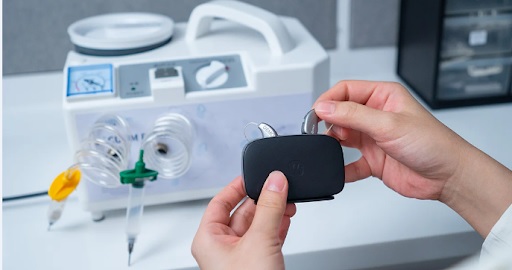Experience a new level of hearing aid performance Unlock it with Real Ear Measurement technology #SuperiorHearing #RealEarMeasurement
Real ear measurement (REM) is a critical procedure in the field of audiology, particularly in the fitting of hearing aids. This technique, also known as probe microphone measurement, involves assessing the sound pressure level in the ear canal to ensure that hearing aids are providing the appropriate amplification. REM is regarded as the gold standard for verifying hearing aid performance, offering a precise and individualized approach to hearing aid fitting.
Table of Contents
The Importance of Real Ear Measurement
Hearing aids are complex devices that need to be finely tuned to meet the unique hearing loss profile of each user. The primary goal of hearing aids is to amplify sound so that it is audible and clear, allowing the user to understand speech and enjoy environmental sounds. However, the ear canal’s shape and size vary significantly among individuals, affecting how sound is delivered to the eardrum. These real ear measurement addresses this variability by providing an objective assessment of how a hearing aid performs in the user’s ear.
Traditional methods of fitting hearing aids often rely on manufacturer settings and subjective feedback from the user. While these methods can offer a general improvement in hearing, they lack the precision required for optimal performance. REM, on the other hand, ensures that the amplification provided by the hearing aid matches the prescription targets based on the user’s audiogram. This personalized fitting improves the user’s listening experience, providing clearer speech understanding and more natural sound quality.
How Real Ear Measurement Works
The process of real ear measurement involves several steps. First, a tiny probe microphone is placed in the ear canal, close to the eardrum. This microphone measures the sound levels within the ear canal. The hearing aid is then inserted, and the probe microphone continues to measure the sound levels while the hearing aid is operating. The audiologist presents various sounds, such as speech and noise, through a loudspeaker, and the probe microphone captures how these sounds are amplified by the hearing aid.
The data collected by the probe microphone is displayed on a computer screen, allowing the audiologist to compare the actual amplification to the prescribed targets. Adjustments to the hearing aid are made in real time to ensure that the amplification meets these targets across different frequencies. This process may be repeated several times to achieve the best possible fitting.
Benefits of Real Ear Measurement
The benefits of real ear measurement are manifold. One of the primary advantages is the accuracy it brings to hearing aid fitting. By measuring the sound pressure levels directly in the ear canal, REM provides a precise assessment of hearing aid performance. This precision ensures that the hearing aid delivers the correct amount of amplification, improving speech understanding and overall sound quality.
Another significant benefit is the personalized nature of REM. Every individual’s ear canal is different, and REM takes these differences into account, providing a customized fitting. This individualized approach leads to higher user satisfaction and better hearing outcomes. Users are more likely to wear their hearing aids consistently and benefit from their improved hearing.
REM also enhances the efficiency of the fitting process. Traditional methods often require multiple visits to the audiologist for adjustments and fine-tuning. With REM, the fitting process is more streamlined, as the audiologist can make accurate adjustments during the initial fitting session. This efficiency reduces the need for follow-up appointments and saves time for both the audiologist and the user.
Challenges and Considerations
Despite its many benefits, real ear measurement is not without challenges. One of the primary challenges is the need for specialized equipment and training. Audiologists must be proficient in using probe microphones and interpreting the data they provide. Additionally, the equipment required for REM can be expensive, posing a barrier for some audiology practices.
Another consideration is the cooperation of the user. The process of inserting a probe microphone into the ear canal can be uncomfortable for some individuals, particularly children and those with sensitive ears. Ensuring that the user remains still and quiet during the measurement is crucial for obtaining accurate data.
Moreover, while REM is highly effective, it is not infallible. Variations in ear canal acoustics and the user’s movement can affect the measurements. Therefore, it is essential for audiologists to use their clinical judgment and experience in conjunction with REM data to achieve the best results.
The Future of Real Ear Measurement
The future of real ear measurement looks promising, with ongoing advancements in technology and methodology. Innovations in probe microphone design and software are making REM more accessible and user-friendly. Wireless probe microphones, for instance, offer greater comfort and flexibility, enhancing the user experience.
Additionally, the integration of REM with other audiological assessments and hearing aid technologies is likely to improve the fitting process further. For example, combining REM with speech mapping can provide a more comprehensive understanding of how hearing aids perform in real-world listening situations.
As the importance of personalized healthcare continues to grow, REM will remain a vital tool in audiology. By ensuring that hearing aids are precisely tuned to the user’s unique hearing needs, REM plays a crucial role in improving the quality of life for individuals with hearing loss.
Conclusion
Real ear measurement is an indispensable procedure in the fitting of hearing aids, offering accuracy, personalization, and efficiency. By providing an objective assessment of hearing aid performance within the ear canal, REM ensures that users receive the appropriate amplification for their hearing loss. Despite its challenges, the benefits of REM make it a valuable tool for audiologists and users alike. As technology continues to advance, REM will undoubtedly evolve, further enhancing the hearing aid fitting process and improving outcomes for individuals with hearing loss.
